Ecommerce platforms offer a greatly simplified shopping experience. People can purchase any kind of goods or services in a matter of minutes. We believe you have definitely heard of eBay - one of the most popular marketplaces in the world. Building a marketplace like eBay, however, is a challenging task that involves many crucial steps, from initial market research to testing and maintenance.
Therefore, in this article, we will share steps on how to create a website like eBay, including all the required functionality it should have. We will also cover the ups and downs of creating an auction website while shedding light on approximate costs.
What is eBay about?
Let’s begin with the definition and figuring out what type of website is eBay. It is an online auction website that connects buyers and sellers within B2C and C2C sectors. It means that the marketplace allows entrepreneurs and sellers to place their goods and buyers to purchase them online.
The platform has two possible pricing models: fixed price and auction. The first one is widespread and works like any online store. The second model—auction—means that sellers choose a starting price for their listed product, and interested buyers place bids. When the auction ends, vendors sell the product to the highest bidder.
eBay is one of the most well-known and profitable auction websites. According to Statista’s research, eBay has not only been profitable but also maintained high revenue caps throughout the years.
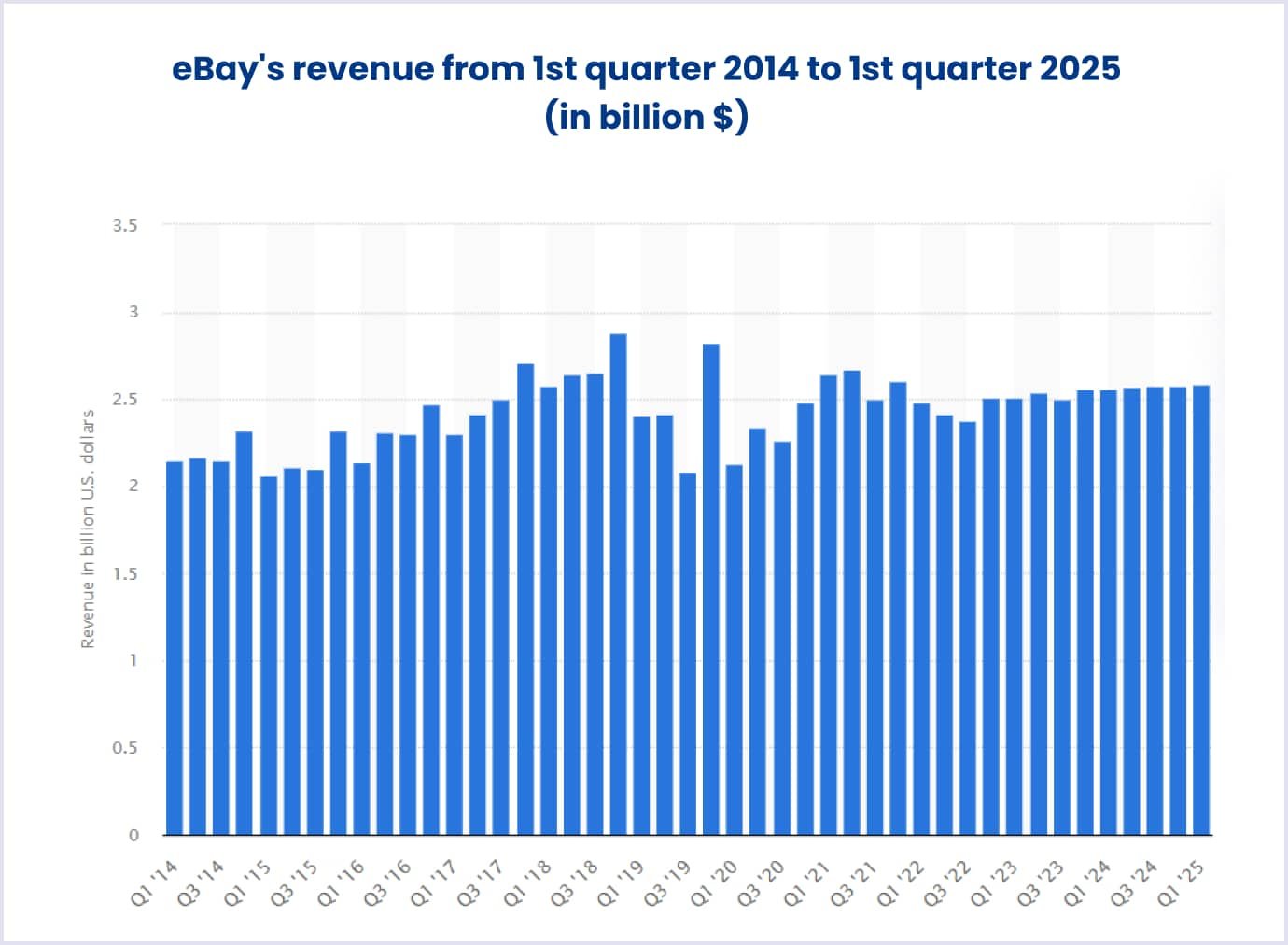
Source: Statista
As you can see, eBay's revenue generated, although it fluctuated, was relatively stable in 2023-2024 and undoubtedly will be in 2025.
Pros and cons of auction websites like eBay
When considering multi-vendor marketplace development like eBay, you need to know the strengths and weaknesses of similar platforms, with their respective ups and downs. This knowledge will help you stand out from other marketplace rivals and attract customers, especially sellers. They evaluate your platform rules and guidelines and decide whether to join your platform or not.
So, let’s take a look at the advantages and disadvantages of websites like eBay for users.
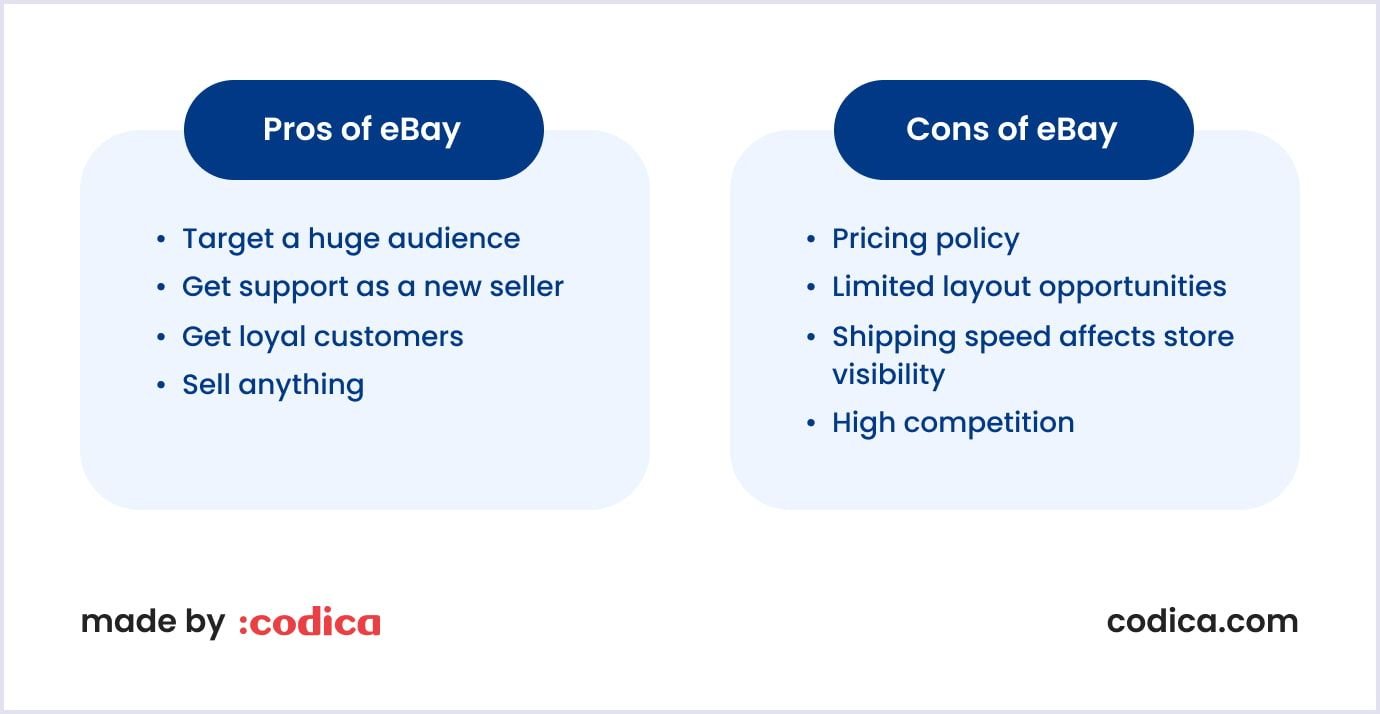
Pros of eBay
Target a huge audience
The core benefit of selling on eBay is its high traffic. However, reaching the desired traffic is challenging without solving a chicken and egg problem. The problem arises because buyers won't use the marketplace if there aren't enough products or services available, and sellers won't join if there aren't enough buyers. Thus, regarding eBay-like platforms, following the strategy where buyers are sellers and vice versa can be highly beneficial to build up an audience.
This fact makes starting an online marketplace a beneficial solution for both sellers and platform owners. It works the following way: vendors can provide tons of products and target a huge audience of potential customers. When buyers start purchasing goods, sellers pay different commissions and fees to marketplace owners. This way, it becomes a beneficial mechanism for website vendors and entrepreneurs.
Get support as a new seller
To launch a store, a new seller can read the guidelines for starting a successful eBay business. In this regard, eBay offers different community features like discussion boards and question-and-answer (Q&A) forums. This way, they can get important knowledge from the vendors who have already succeeded in the marketplace.
Get loyal customers
If sellers are interested in growing their profit in the marketplace, they will want to offer a perfect buying experience for customers to get loyal clients. This can be achieved by providing high-quality goods, offering fast delivery and shipping, and rewarding repeat customers with certain bonuses. Put simply, once a sale is made, sellers have good prospects of getting repeat buyers by providing excellent service or high product quality.
Thus, it’s a win-win strategy for both parties: sellers want to stand out from the crowd and provide high-quality products due to high competition that generates more profit for the marketplace.
Sell anything
One of the advantages of auction websites like eBay is the all-in-one approach: vendors can sell and buy literally anything. Regardless of the niche, sellers can definitely find a specific audience.
It is beneficial for both marketplace owners and users: buyers can find any product and purchase it, thus allowing the platform to get more transaction fees. This way, everybody wins.
Cons of eBay
Limited layout opportunities
The platform allows sellers to create a personal online store layout with the ability to manage the position of different elements. However, many restrictions still exist in manipulating the layout structure and elements’ positioning. This is explained by the fact that most websites, like eBay, are interested in promoting the products, not the sellers. For this reason, the website primarily determines and restricts the management features.
Shipping speed affects store visibility
The platform rewards sellers who can ship the item on the same day or the following day. If vendors face certain shipping challenges, their online store visibility will decrease.
High competition
eBay has millions of users willing to sell their products, so vendors will face huge competition. To overcome this issue, they need to offer a unique product, cut prices, or avoid listing some categories. Anyway, sellers should find a strategy to stand out from the crowd.
To conclude, websites like eBay have both benefits and drawbacks. You need to consider all of them and find the optimal balance to satisfy all the platform parties.

Aspects to consider before building a website like eBay
Starting your marketplace with the right steps will ensure that you spend your resources in an optimized way. That is why we cover several aspects to consider before starting your website like eBay.
Find your specific niche to overcome huge competition
The rivalry in the marketplace domain is pretty high. Nowadays, it may become rather complicated to succeed in developing an all-in-one platform with a wide range of products and services. The matter is that ecommerce juggernauts such as Amazon, Etsy, AliExpress, and others have already occupied many market segments and are trying to leave behind any competitors.
There is a more efficient way to start your business. Choose a specific niche initially to narrow your focus and stand out from the competitors in the market. For this reason, our product discovery is an excellent choice as we conduct all the research, ensuring your product starts on solid ground.
Choose the optimal business model
After finding a niche, our team can analyze and suggest ways you will earn money from the marketplace. Depending on the type (vertical/horizontal), participants (C2C, B2C, C2B, B2B), and niche (goods, services, information, investment/fundraising), you can choose a particular monetization model.
Now, let’s take a look at the main revenue sources you need to take into account.
- Commission. The platform receives a percentage or a fixed sum when a buyer pays a seller.
- Membership fee. This revenue option is quite good when you provide high value to the customers. For example, you can offer customers a wider range of vendors to have more product options.
- Listing fee. This monetization tool allows you to charge sellers for each listing.
- Lead fee. It is a seller-oriented revenue model with the following flow: buyers place requests, and vendors pay a fee to bid on these consumers.
- Featured listings and ads. General listing is entirely free, but in case sellers want to get featured, you can offer different types of posting: the top ad of a category or post on the marketplace homepage, etc.
Come up with an idea for solving the chicken and egg problem
Who should you acquire first: consumers or providers? Is it reasonable to target the sides one after another, or is it more beneficial to invite them simultaneously? There are multiple solutions to the chicken and egg problem, and all of them deserve your attention. Here are the most efficient tips:
- Acquire the hardest side first;
- Fix attention on a particular market;
- Stimulate the most essential platform party;
- Arrange astounding live-action;
- Tie up a deal with an influencer;
- Take up a producer’s position;
- Set a time or demand constraint.
The functionality required for an eBay-like website
After discovering some essential data on the future product, we start planning the entire development process. Thus, one of the most important parts of this planning is encompassing the functionality required.
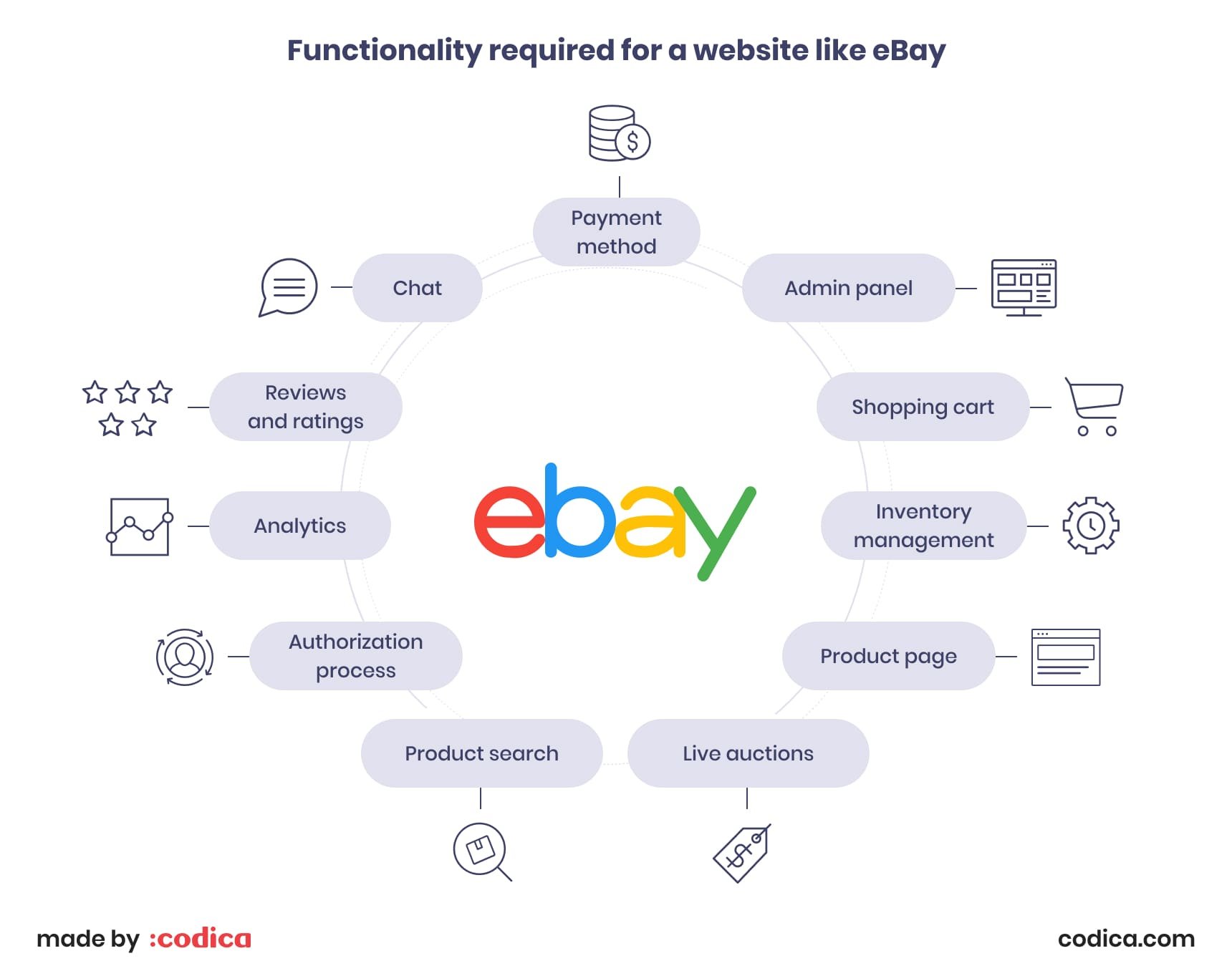
Authorization process
This feature is important for dividing users into sellers and buyers. Vendors create online stores, list their items, and provide product descriptions and details. Consumers search for goods, read a product’s page, visit online stores, and contact suppliers to purchase items.
Also, authorization allows platform users to provide personal data (name, email address, password) for further purchases.
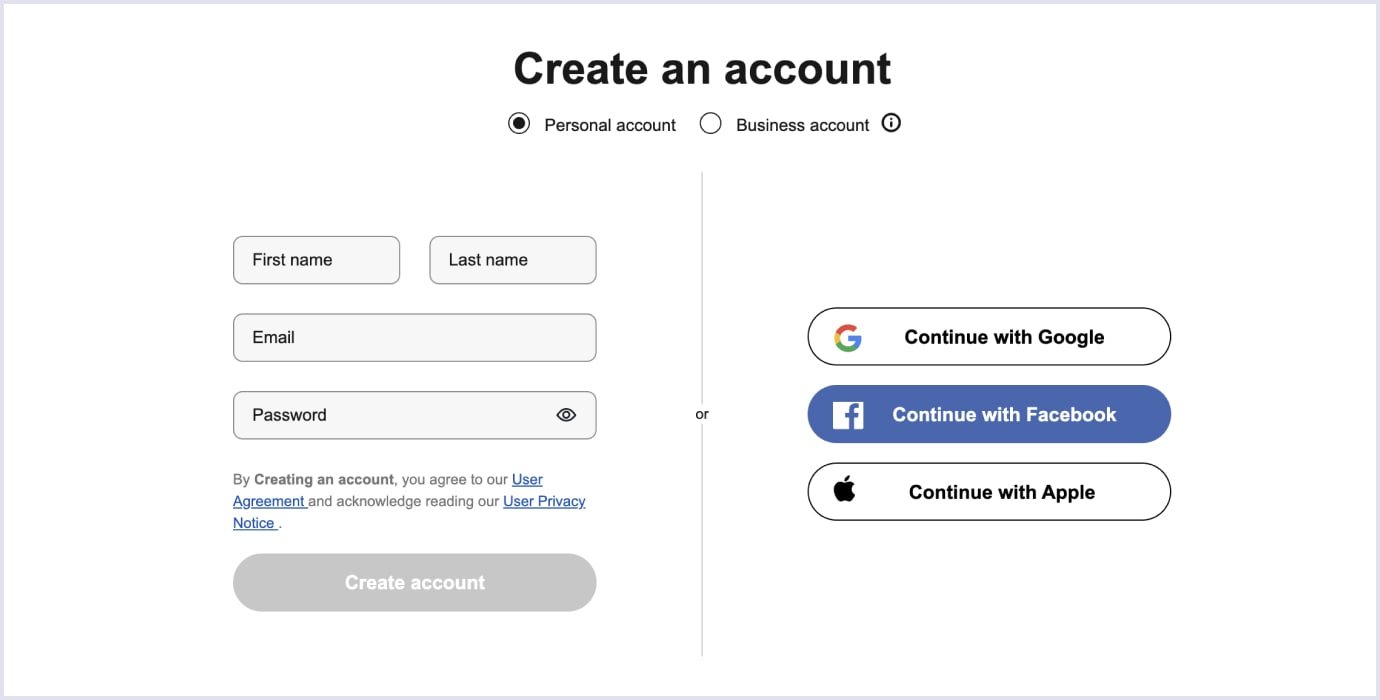
Source: eBay
Inventory management
It boosts sellers’ user experience. With inventory management functionality in place, vendors can manage their listings: publish, view, modify, and delete. It also allows suppliers to track their product shipping status.
Admin panel
Every online website requires an administrator who can handle any operation and solve any issue. An online marketplace with auctions is not an exception. The admin panel allows you to monitor the interaction between sellers and buyers, their transactions’ status, whether both sides comply with the cooperation rules, etc.
Product search
Provide users with multiple product and service categories on your platform. This feature allows consumers to easily navigate and search for particular items using different advanced filters. They specify product category, condition, price range, buying format, seller, shipping options, etc.
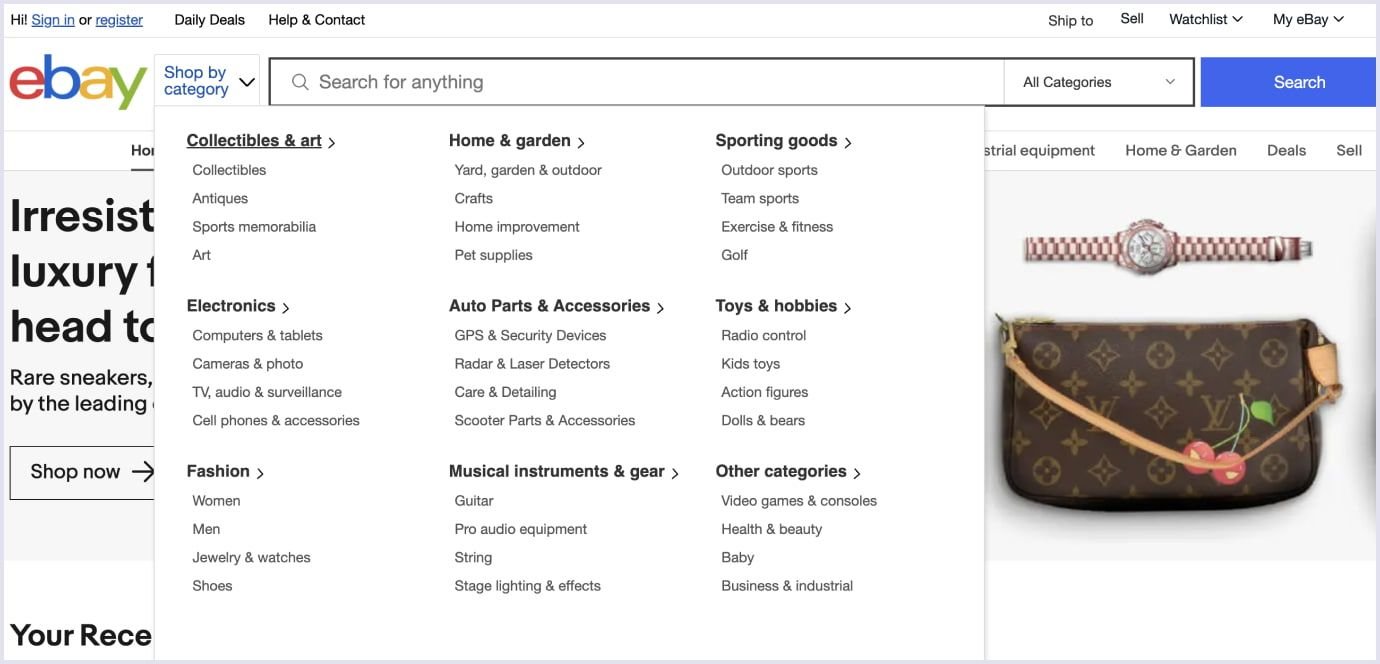
Source: eBay
To make the search even more convenient, eBay has integrated Google's Vertex AI and vector search, which allows for searching items based on context and discovering products even if you don't know the exact wording.
Product page
It lets customers see the item details, payment, shipping, and delivery information and get the seller’s contacts. At this stage, buyers conclude whether they want to buy a product.
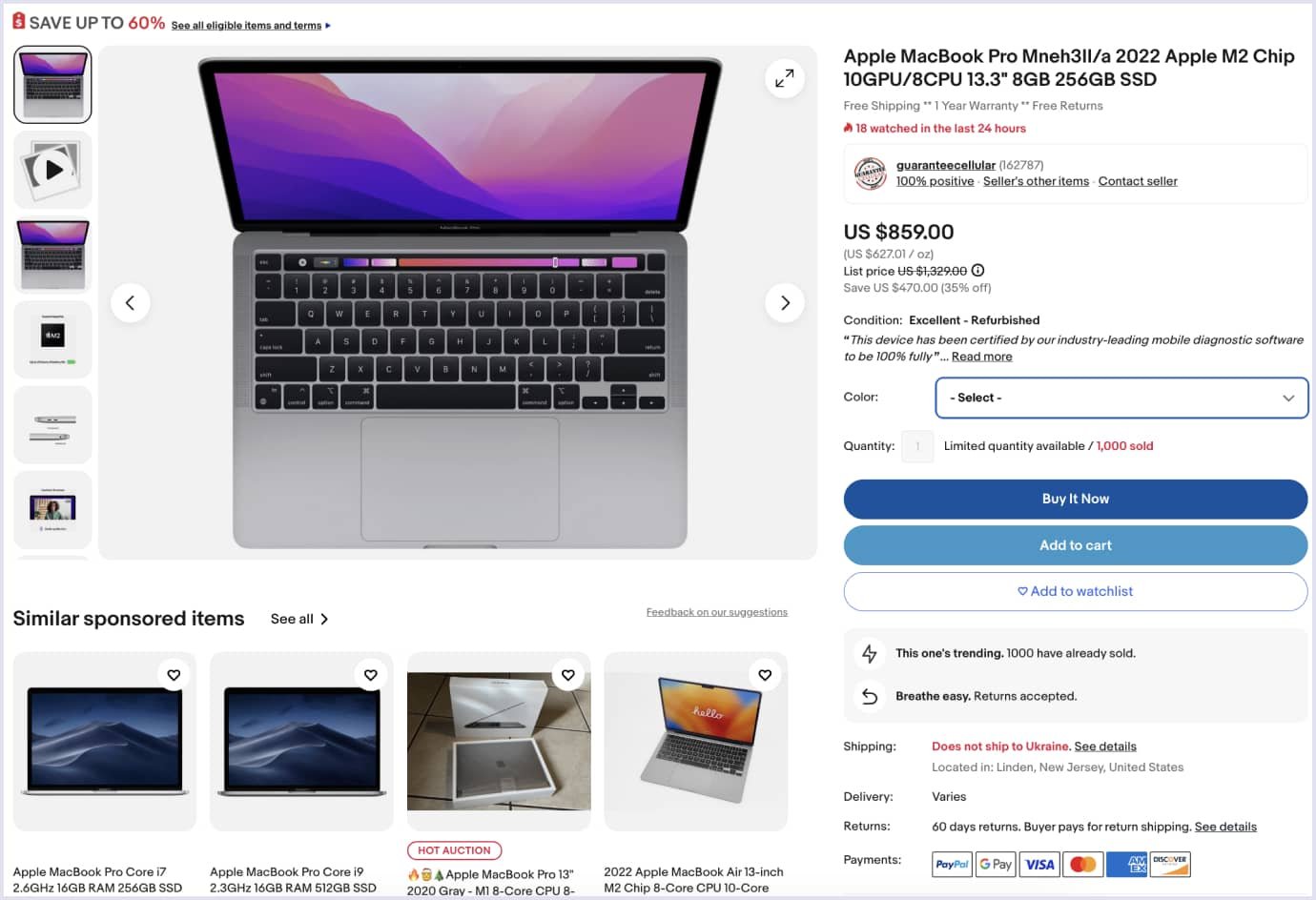
Source: eBay
eBay offers a “magical listing” tool, which uses image recognition and generative AI to produce listings. Thus, sellers can save up to 50% of time creating product listings.
Live auctions
One main feature that makes eBay stand out from its competitors is live auctions. This unique function allows sellers to choose a starting price for their listed product, and interested buyers place bids. When the auction ends, vendors sell the product to the highest bidder.

Source: eBay
Shopping cart
It’s impossible to imagine a functional auction website without a shopping cart. It allows buyers to pick several item options from different stores and purchase them in one stroke. Also, consumers can manage their in-cart items, changing the product quantity or removing it.
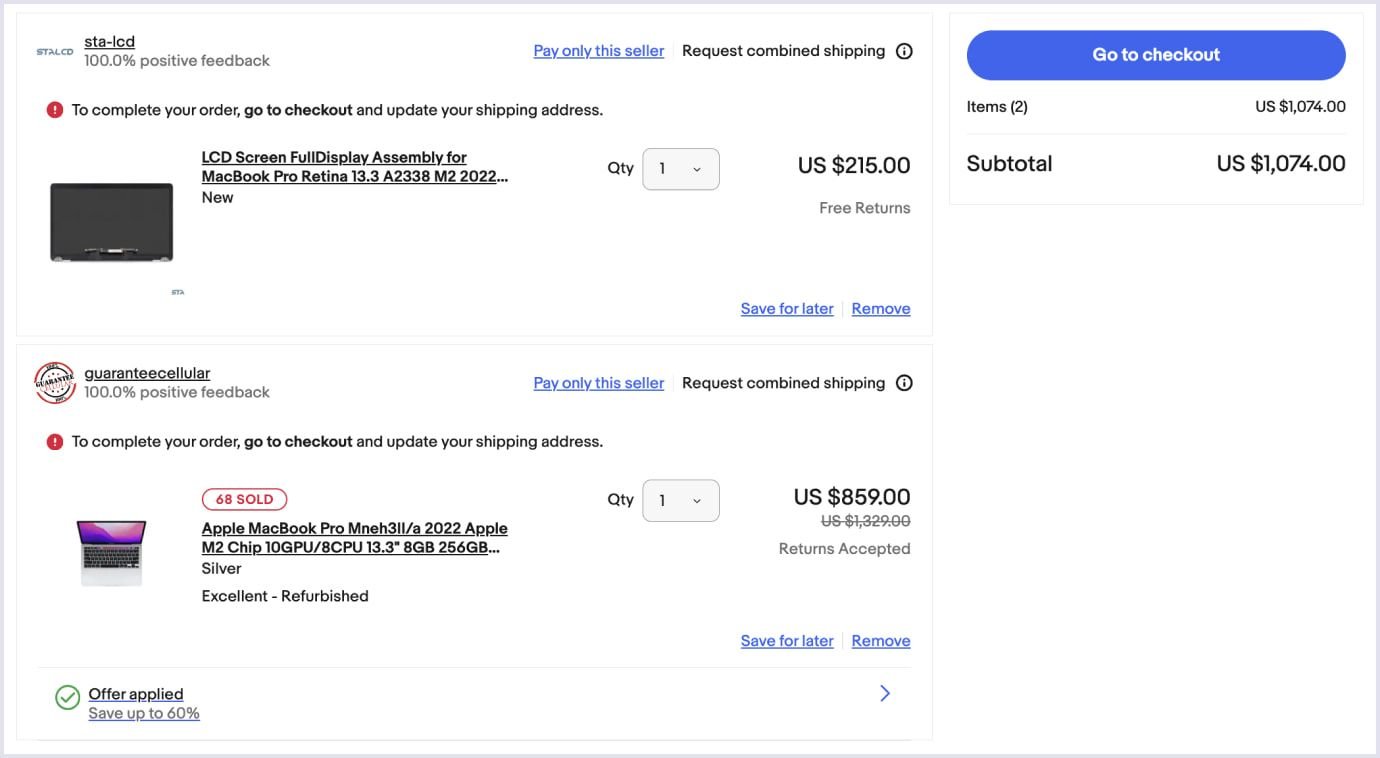
Source: eBay
Chat
The integrated feature allows website users to get in touch and discuss the transaction details.
Payment method
This feature allows consumers to buy an item and the seller to get the requested price. eBay customers can do it using different payment methods: credit/debit card, Stripe, and PayPal.
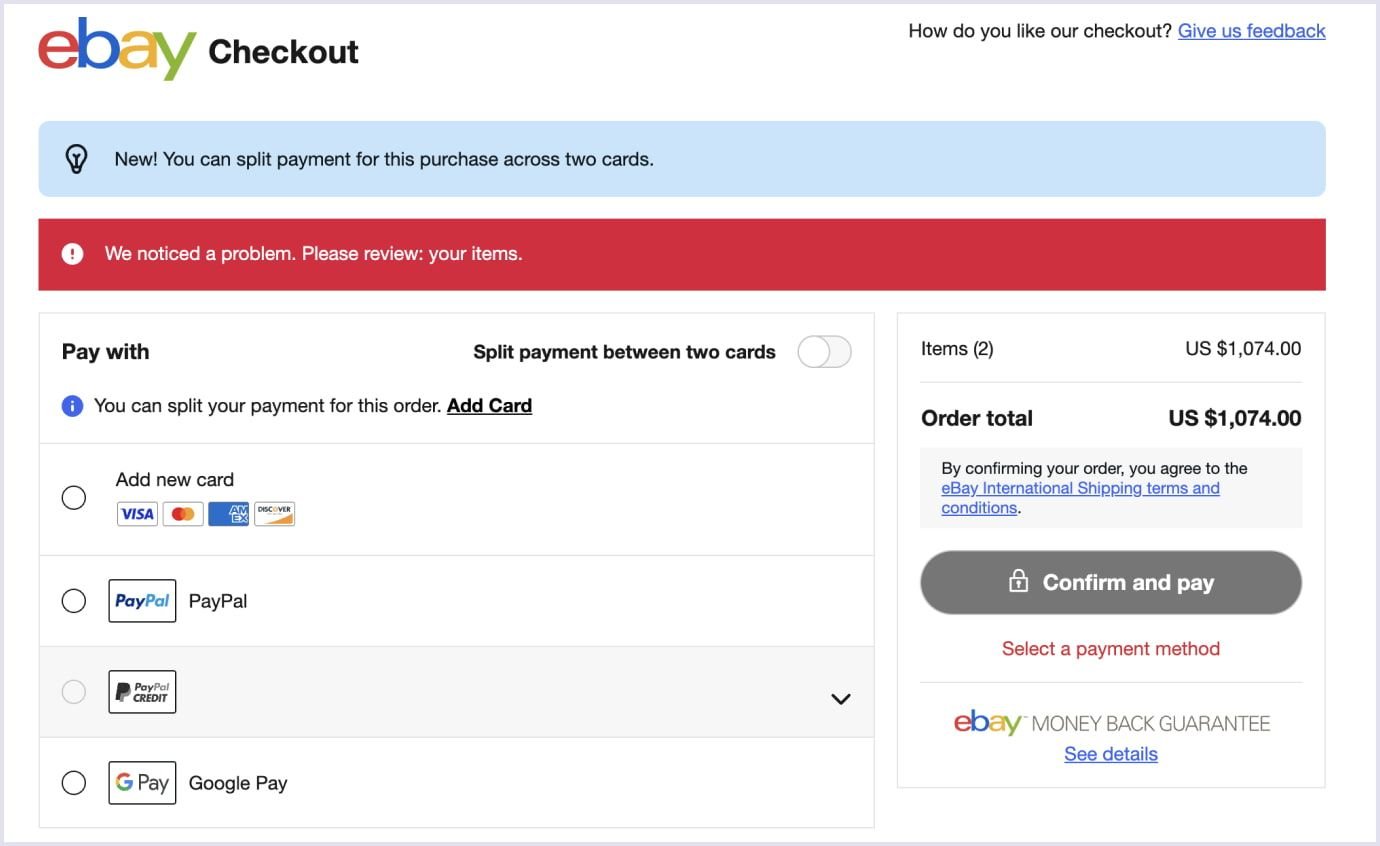
Source: eBay
Reviews and ratings
The current option allows buyers to increase their trustworthiness with the platform and its sellers. Thus, the marketplace sellers are interested in providing excellent service and keeping their store ratings high.
Analytics
The tool allows suppliers to monitor their business activity, including the most-visited products, session duration, the number of views by date, and total sales amount.
Agentic AI
eBay has introduced an AI shopping agent that appears at any step of the buyer journey. It can answer your questions, recommend products, and even predict what you need next and make relevant suggestions.
Technical stack for a website like eBay
The last important aspect of the discovery is the technical stack the development team should use to create such a complex platform. Determining the exact functionality you want on your online website like eBay is pretty good.
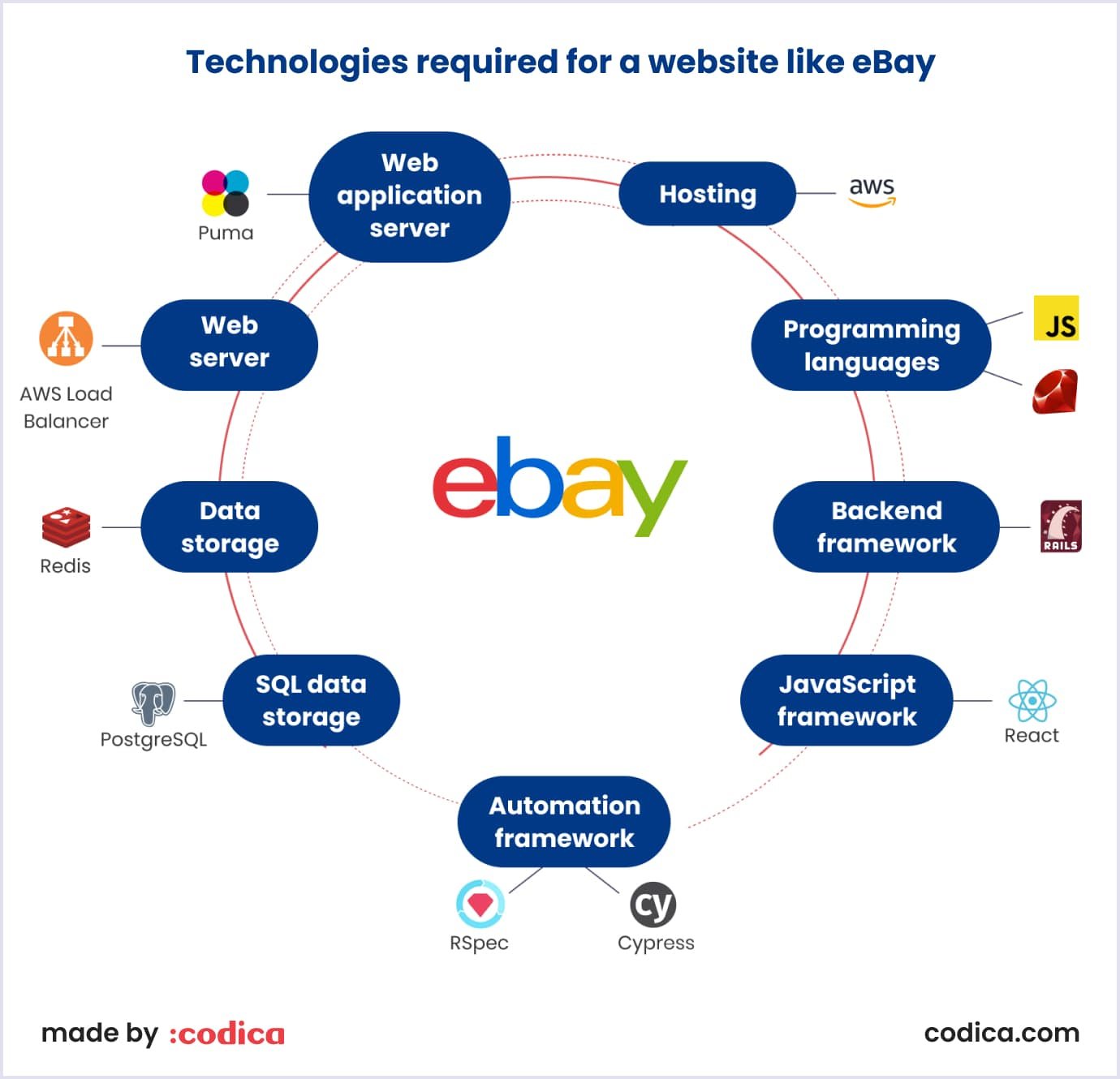
Let’s examine the main online marketplace development tools and technologies required to implement platform features before building a website like eBay.
Backend
Backend is responsible for all the marketplace logic and operations handled on the server side: processing your filter criteria, uploading the items in the feed, providing you with the product’s page and its data, etc.
We recommend using the most up-to-date and modern tools, as they allow you to make your product scalable, maintainable, and sustainable. To develop the server-side part, you can take into consideration Ruby, Ruby on Rails, ElasticSearch, Redis, i18n gem, MySQL, and Sidekiq.
Frontend
At Codica, we use the technologies that allow us to provide customers with a brilliant UI solution with both high performance and stability. We believe you should take a look at the following tech stack for frontend development: HTML5, CSS3, JS, React, Vue.js, Angular.
Apart from coding, you should create an efficient development process and pick a suitable hosting service. To achieve this, pay attention to the next tools: AWS S3, GitLab, and Digital Ocean.
Steps in developing a marketplace like eBay
The more complex the product, the more challenging it is to develop. However, the difficulty level can be easily overcome with the right approach. At Codica, we know how to make a website like eBay, and we do this by dividing the entire online marketplace development process into sizeable milestones. Let’s take a closer peek at those.
Step 1: Market research and product discovery
If you are going to build a marketplace website like eBay, you need to think upfront and solve the core challenges that may appear in the future. This will help you save time and money when the platform is built and functioning. Thus, in the majority of scenarios, the development starts with product discovery.
At Codica, our product discovery services encompass numerous aspects before design and development start. It is somewhat similar to the business model canvas.
Like this lean startup template, product discovery can help you realize the business model in a structured way. It allows you to gather information about the customers you serve, what value propositions are offered through what channels, and how you can generate profit.
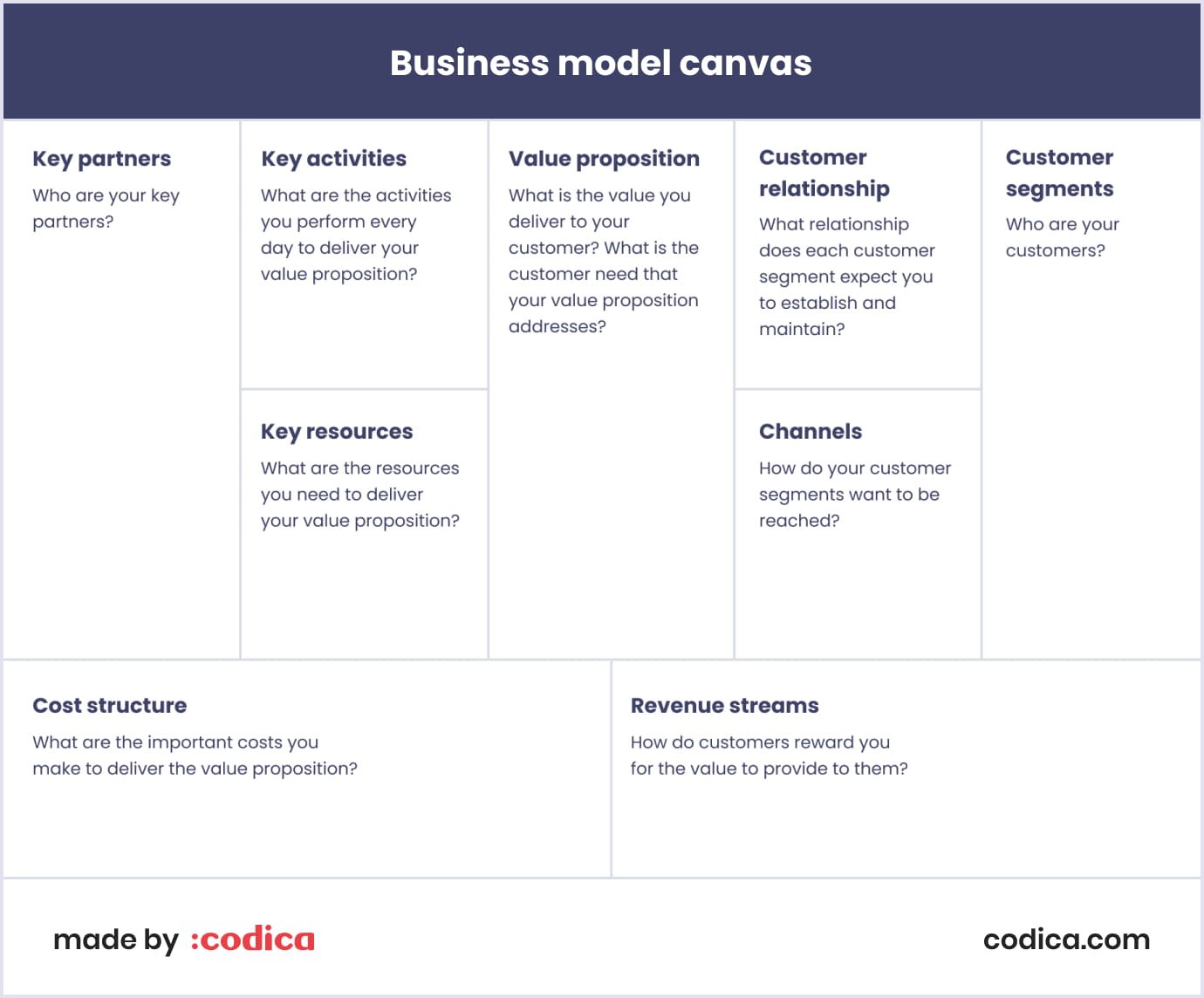
Step 2: Prototype development
An irreplaceable step in creating a website like eBay is creating a prototype. Essentially, it is a tangible blueprint that encapsulates the vision and functionality of the platform.
A perfect prototype is made based on market research, chosen business model and a tech stack, and other aspects. However, considering all the previous steps, you should have everything needed at this point. So, what should you know about prototyping?
First, let’s talk about user persona development. User personas are detailed descriptions representing your target audience segments. These personas should encompass demographic information, preferences, pain points, and behavioral patterns. Why need them? Well, knowing your users, you can tailor the prototype to address their needs effectively.
What else is there in prototypes?
Wireframing and mockups. With wireframing and mockup tools, you can create skeletal outlines of your marketplace's interface. It is an efficient way to structure navigation pathways, organize content, and design key features. Iterate on these wireframes through feedback loops and user testing to refine the user experience and optimize usability.
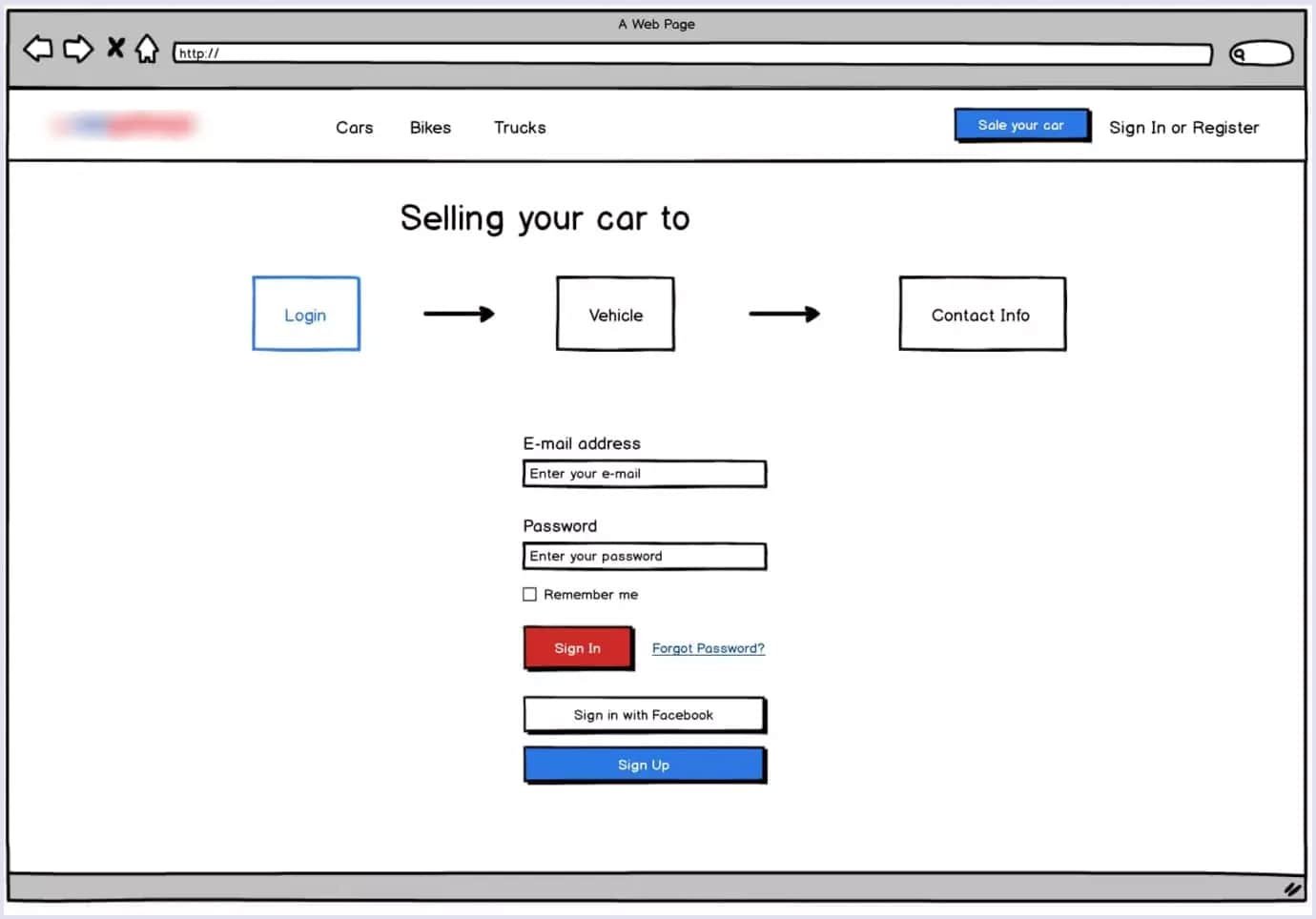
Also, consider functional prototyping. With its help, you can transition from wireframes to functional prototypes that simulate the marketplace's core functionalities. For instance, you can develop clickable prototypes using prototyping tools or software development frameworks and incorporate features such as user registration, product listings, search functionality, checkout processes, and seller tools.
At Codica, we develop clickable prototypes during the project discovery phase. This ensures that you can review how your solution will look and work early. Thus, you can adjust features if needed before starting full-scale development.
Step 3: UX and UI design importance
Website design is the first thing users see when visiting your platform. Thus, it is crucial to consider UI/UX design services when building a website like eBay. Clearly, UI/UX design as a whole is a huge niche with many moving parts. So, let’s narrow it down and see the most crucial design aspects that play a huge role in eBay-like marketplace development.
Navigation
In short, make it as simple as possible. In ecommerce website design, try to avoid multiple dropdowns and nested lists. The easier it is to find a “Buy Now” button, the more purchases are made. Users tend to evade complex logic and too many clicks. Build a comprehensive user journey to make clients happy while browsing your auction website.
Trust and security
Credibility is the key to success. Create trust-based relations with users, giving you more chances to get loyal customers in the long run.
In the design realm, this means using only high-quality, real product images and full item descriptions. This greatly boosts the buyers’ purchase experience. Also, providing users with reliable payment options and a refund policy increases your credibility.
User involvement
Provide visitors with clear benefits of your platform, making it unique and stand out from rivals. Also, users love staying up-to-date, and following modern marketplace trends can greatly help in this regard. For example, one of the tactics eBay uses involves users by showing them popular daily deals and categories with quick access.
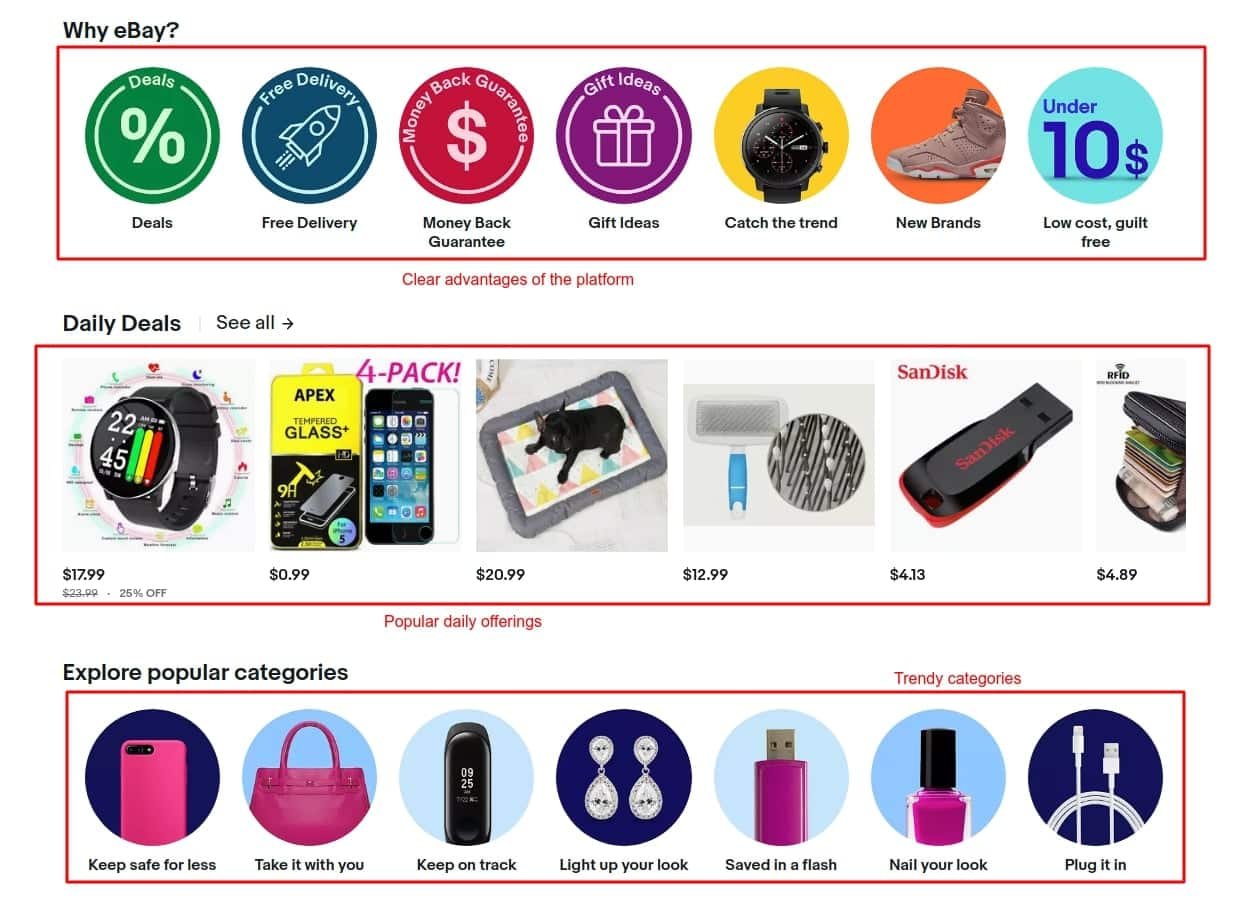
Source: eBay
To conclude, to build a successful website like eBay, you should pay much attention to the UI/UX design services as marketplace design defines the first impression of users and further ease of use. Make the navigation intuitive and visible to users so they find it simple to visit a certain page.
Also, require high-quality photos and detailed product descriptions from sellers to build trust-based relationships with buyers. Finally, try to stand out by making your platform unique, offering popular daily deals, and tailoring content to users’ preferences.

Step 4: MVP development
Moving from the prototyping, a marketplace MVP (minimum viable product) is a natural successor you should look at. Unlike prototype, it is a streamlined and working version of your marketplace with a focus only on core functionality and value proposition.
Again, thanks to previous steps and prototype development, you already know which technologies to use as well as have all possible knowledge about the market you’re entering.
To make the most out of our MVP, identify the core features it should offer. Distill your marketplace concept into a set of essential features that constitute its minimum viable offering. Prioritize features that are indispensable for facilitating transactions, connecting buyers and sellers, and delivering value to users.
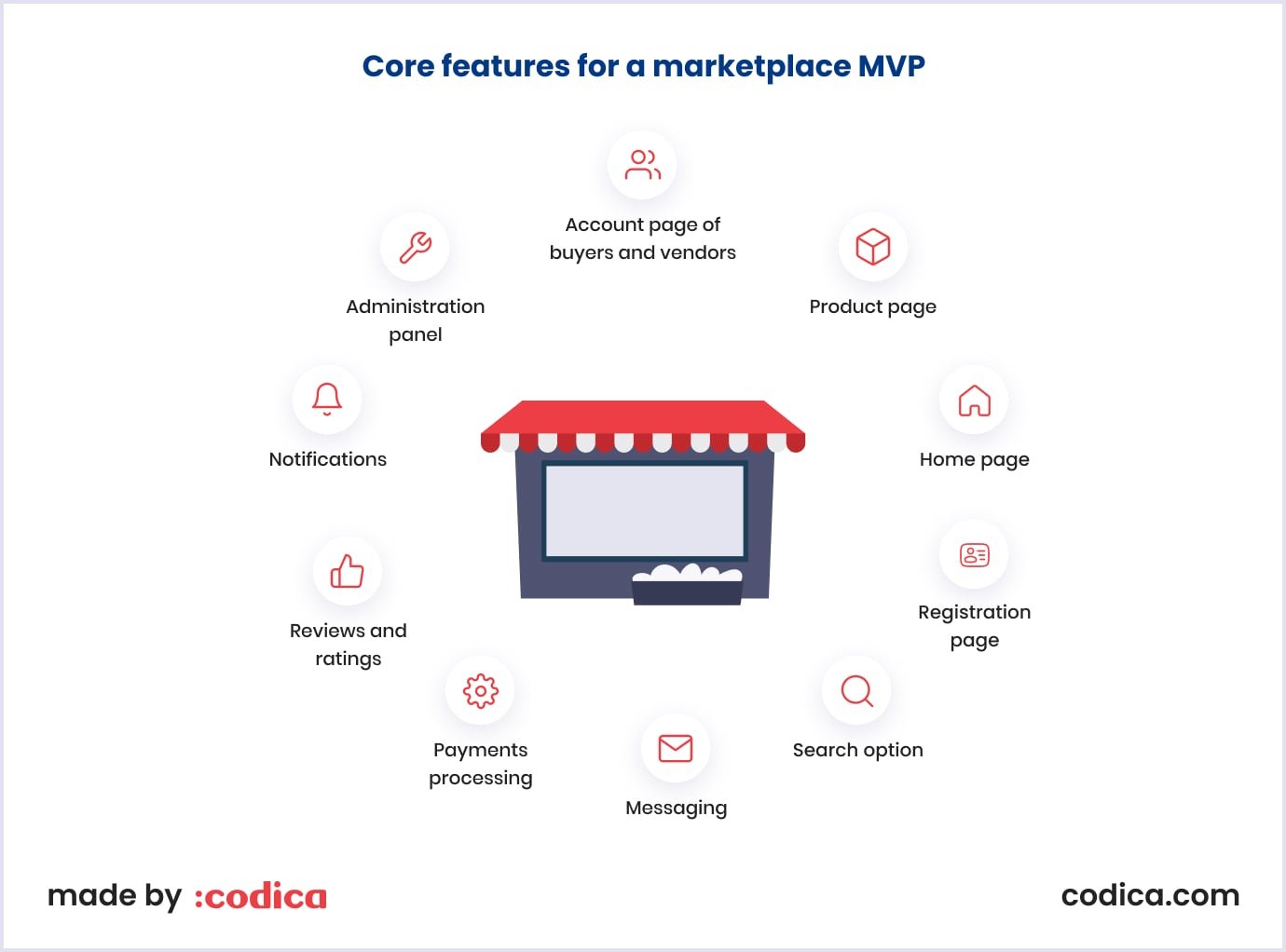
With the help of prototype you built earlier, translate your wireframes and prototypes into functional components and features of your marketplace MVP architecture. Develop core functionalities such as user registration, product listings, search functionality, messaging systems, and transaction processing.
After all, make sure to adopt an iterative approach to MVP development services, releasing early versions of your marketplace to gather feedback from real users. Conduct usability testing, A/B testing, and beta testing to identify usability issues, technical bugs, and areas for improvement. Iterate on the MVP based on user feedback, refining features and enhancing the overall user experience iteratively.
Step 5: Quality assurance
Once the marketplace is built, software testing comes into play. Through QA, or quality assurance services, our specialists employ various types of testing, ensuring different parts of the platform work as intended. For instance, there are:
- Performance testing. Assesses how well the app performs under expected stress and loads, ensuring it supports the anticipated number of simultaneous users, manages memory usage, and maintains optimal response times.
- Compatibility testing. Checks the marketplace’s compatibility with various browsers, allowing you to choose the most popular ones for your customers.
- Security testing. Validates the secure storage of sensitive data and ensures the resilience of the product against common security attacks.
- Backup and recovery testing. Verifies the app's capability to revert to the previous version and recover data in the event of a fault.
Step 6: Maintenance and support
Even after your marketplace is released to the public, there’s always room for performance monitoring and updates. For instance, we monitor various parts of the platform. We conduct analytical monitoring to identify bottlenecks and find ways to increase sales, and we analyze the performance to see if everything works as intended.
Cost to build a website like eBay
Before making a website like eBay, it’s important to understand what budget you will need.
To calculate the cost of an auction website, you must consider numerous aspects, such as the functionality you want, the development process, testing, marketing expenses, and more. Another aspect that influences the cost of your platform is the hourly rate of your software development team.
In this regard, we used the list of functionality discussed earlier in this article. As for the hourly rate, we took $50/hour, the average for Eastern European development agencies.
| The cost to build an auction website | ||
| Features | Time, hours | Cost (50$/h) |
| Design | ||
| UX development | 56 | $2,800 |
| UI development | 80 | $4,000 |
| Architecture | ||
| Project setup | 16 | $800 |
| DB structure | 32 | $1,600 |
| Integrations | ||
| Payment (Stripe or PayPal) | 64 | $3,200 |
| Shipment (Shippo) | 32 | $1,600 |
| Main functionality | ||
| Authorization and security | 64 | $3,200 |
| User profiles | 42 | $2,100 |
| Homepage | 64 | $3,200 |
| Search and filters | 72 | $3,600 |
| Product page | 42 | $2,100 |
| Auction functionality | 104 | $5,200 |
| Reviews and ratings | 48 | $2,400 |
| Shopping cart | 64 | $3,200 |
| Notifications | 32 | $1,600 |
| Buyer panel | 96 | $4,800 |
| Vendor panel | 120 | $6,000 |
| Admin panel | 104 | $5,200 |
| Non-development activity | ||
| Project management | 48 | $2,400 |
| Quality assurance | 64 | $3,200 |
| Code review | 48 | $2,400 |
| Total | 1292 | $64,600 |
So, how much does it cost to make an auction website? The minimum price is $64,600. Of course, the cost will be higher if you hire a development team from Western Europe or the United States. On the other hand, consider that the price may change dramatically, and only your software development partner can provide a final estimate based on your particular requirements.
Read also: How Much Does It Cost to Build an Online Marketplace in 2025
Codica's expertise in marketplace development
Over the years, we have gained impressive experience in building complex online marketplaces like eBay. We focus on creating unique, fast-loading, secure, engaging, and user-friendly ecommerce websites that drive traffic, increase conversions, and increase sales. In online marketplace development services, our specialists thoroughly analyze the end user's needs to build an auction website that your customers will love.
At Codica, we have experience building any ecommerce marketplace platform differing in functionality, complexity, and content. One such example is a multi-vendor marketplace platform, a very significant project we were happy to work on.

Built entirely from scratch, this marketplace comprises C2C and B2C segments, allowing it to cater to a much wider audience. From the marketplace perspective, it has all the required functionality to operate, scale, and even analyze performance successfully.
As marketplaces tend to grow huge, the platform we built is highly scalable and features various integrations to fulfill customer needs. For instance, UI/UX design, which we covered earlier, plays a crucial role in this marketplace, making it user-friendly and not overwhelming.
Additionally, the integrations we populated the platform with are also important. As such, we implemented an advanced search system so that users can always stay on track of their journey. We also implemented Google Maps, which is of great help for customers shopping locally.
Here’s a sneak peek demonstration of how the multi-vendor marketplace we built works in greater detail.
Bottom line
Success stories of auction websites like eBay attract many entrepreneurs to build a similar platform. It is fully reasonable, as knowing how to build a website like eBay pays off with tons of users and a high conversion rate, thus generating a lot of profit. However, marketplace development can be a tough hill to climb.
In this regard, having an experienced custom software development company is beneficial. The Codica team has built multiple marketplaces and auction websites, and we will gladly help you build an auction marketplace, too. As always, you can refer to our blog page, where we regularly cover new aspects of software development. Additionally, get in touch with us if you are looking for a team to transform your idea into a successful product.
